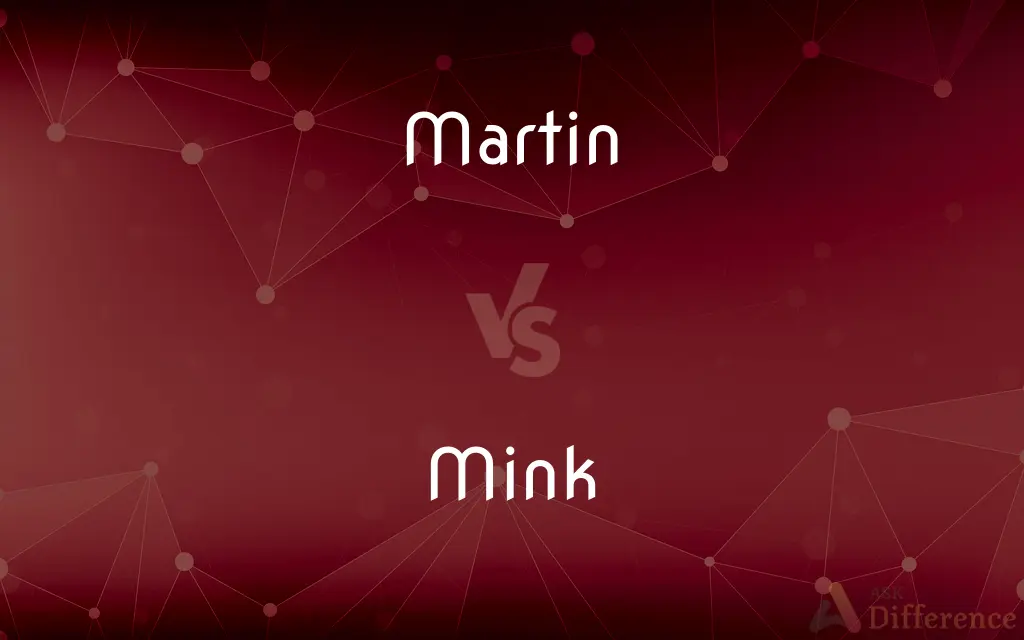Martin vs. Mink — What's the Difference?
By Fiza Rafique & Maham Liaqat — Updated on April 22, 2024
Martin and mink are both mammals, but martins are small, insectivorous birds while minks are semi-aquatic, carnivorous mammals known for their luxurious fur.

Difference Between Martin and Mink
Table of Contents
ADVERTISEMENT
Key Differences
Martins, part of the swallow family, are known for their aerial agility and preference for flying insects, which they catch mid-flight. Minks, on the other hand, are members of the mustelid family, which also includes weasels and otters, and are known for their strong swimming abilities and diet that includes fish and small mammals.
Martins are commonly found in a variety of environments including woodlands, farmlands, and urban areas, often nesting in man-made structures. Whereas minks are typically found near water bodies like rivers, lakes, and marshes, using their webbed feet and streamlined bodies to navigate their aquatic habitats.
Martins have a migratory lifestyle, traveling long distances between breeding and wintering grounds depending on the season. Minks, however, are largely territorial and do not migrate, maintaining defined home ranges throughout the year.
The nesting behavior of martins involves building nests out of twigs and mud in cavities, often forming colonies. Minks, in contrast, are solitary except during the breeding season and make dens in burrows or hollow logs near water.
Conservation status varies significantly between the two; many martin species are abundant and face few threats, while minks, especially the European mink, face threats from habitat loss and competition, leading to endangered status in some areas.
ADVERTISEMENT
Comparison Chart
Classification
Bird, Swallow family
Mammal, Mustelid family
Habitat
Woodlands, urban areas, uses man-made structures
Near water bodies, dense vegetation
Diet
Insectivorous, catches insects in flight
Carnivorous, eats fish and small mammals
Behavior
Migratory, forms colonies
Non-migratory, solitary
Conservation Status
Generally stable, varies by species
Some species endangered, habitat-sensitive
Compare with Definitions
Martin
An insectivore, catching its prey on the wing during flight.
Martins skillfully snatch insects out of the air while in flight.
Mink
An animal impacted by environmental changes and human activities.
Mink populations have declined in areas heavily polluted or altered by human development.
Martin
A bird known for its migratory habits, often traveling long distances seasonally.
Martins are preparing for their annual migration south as winter approaches.
Mink
A solitary animal, often aggressive towards others of its species except during breeding.
The mink marked its territory to ward off intruders.
Martin
A species that often benefits from human-provided nesting options.
Many homeowners install martin houses to attract these birds for insect control.
Mink
An example of successful invasive species management in some regions.
Efforts to control the spread of non-native minks have been implemented to protect local wildlife.
Martin
A social bird, often nesting in colonies and interacting frequently with others of its species.
Martins gathered at the newly installed birdhouses, chattering noisily.
Mink
A predator that is proficient in both terrestrial and aquatic environments.
Minks hunt along the water's edge, searching for fish and frogs.
Martin
Any of several species of small passerine birds, typically with a glossy blue-black plumage and long wings.
The purple martin is popular for its beneficial role in controlling flying insects.
Mink
A small, dark-colored, semi-aquatic mammal known for its luxurious fur.
The mink's thick, glossy coat has made it a target for the fur industry.
Martin
A swift-flying insectivorous songbird of the swallow family, typically having a less strongly forked tail than a swallow.
Mink
Mink are dark-colored, semiaquatic, carnivorous mammals of the genera Neogale and Mustela and part of the family Mustelidae, which also includes weasels, otters, and ferrets. There are two extant species referred to as "mink": the American mink and the European mink.
Martin
Any of various swallows, such as the house martin or the purple martin.
Mink
Either of two semiaquatic mustelid carnivores, Mustela lutreola of Europe or Neovison vison of North America, having a pointed snout, short legs, and partly webbed toes. The North American species is bred for its commercially valuable fur.
Martin
Any of various passerine birds of the family Hirundinidae, which also includes swallows, that catch insects whilst flying.
Mink
The soft thick lustrous fur of a mink.
Martin
A perforated stone-faced runner for grinding.
Mink
A coat, stole, or hat made of this fur.
Martin
A perforated stone-faced runner for grinding.
Mink
(plural mink or minks) Any of various semi-aquatic, carnivorous mammals in the Mustelinae subfamily, similar to weasels, with dark fur, native to Europe and America, of which two species in different genera are extant: the American mink (Neovison vison) and the European mink (Mustela lutreola).
Martin
One of several species of swallows, usually having the tail less deeply forked than the tail of the common swallows.
Mink
(plural mink) The fur or pelt of a mink, used to make apparel.
Martin
French bishop who is a patron saint of France (died in 397)
Mink
(plural minks) An article of clothing made of mink.
Martin
United States actor and comedian (born in 1945)
Mink
(plural minks) An individual with poor personal hygiene; a smelly person.
Martin
United States actress (1913-1990)
Mink
A carnivorous mammal of the genus Mustela (foremrly Putorius), allied to the weasel. The European mink is Mustela lutreola. The common American mink (Mustela vison) varies from yellowish brown to black. Its fur is highly valued. Called also minx, nurik, and vison.
Martin
United States singer (1917-1995)
Mink
The fur of the mink{1}. Together with sable, it is one of the most expensive furs not taken from endangerd species. When the fur is taken from animals grown on a farm, it called ranch mink.
Martin
Any of various swallows with squarish or slightly forked tail and long pointed wings; migrate around Martinmas
Mink
The expensive fur of a mink
Mink
Fur coat made from the soft lustrous fur of minks
Mink
Slender-bodied semiaquatic mammal having partially webbed feet; valued for its fur
Common Curiosities
What do minks eat?
Minks are carnivorous and primarily eat fish and small mammals.
How do martins and minks interact with their environment?
Martins are often seen flying in open areas, whereas minks are more secretive and stick close to water.
Are minks solitary or social animals?
Minks are mostly solitary, except during the breeding season.
Where do martins and minks typically live?
Martins often inhabit areas around human structures and open fields, while minks live near bodies of water.
What do martins eat?
Martins primarily eat insects, which they catch in the air.
Do martins migrate?
Yes, many martin species migrate seasonally.
What distinguishes a martin from a mink?
Martins are birds, whereas minks are mammals.
What are the conservation statuses of martins and minks?
Martin populations are generally stable, while minks, particularly the European variety, can be endangered.
How do martins benefit humans?
Martins help control insect populations.
Can martins and minks be found worldwide?
Martins are found widely in many parts of the world, while mink distribution is more limited and specific to certain regions.
How do martins and minks adapt to their respective environments?
Martins adapt through migration and social nesting, while minks utilize their aquatic skills and solitary nature.
How has human activity affected mink populations?
Habitat destruction and the fur trade have significantly impacted mink populations.
What type of nesting habits do martins have?
Martins nest in colonies, often using artificial structures provided by humans.
What type of breeding habits do minks have?
Minks breed once a year, and are otherwise solitary.
Share Your Discovery

Previous Comparison
Pupil vs. People
Next Comparison
Test vs. ExperimentAuthor Spotlight
Written by
Fiza RafiqueFiza Rafique is a skilled content writer at AskDifference.com, where she meticulously refines and enhances written pieces. Drawing from her vast editorial expertise, Fiza ensures clarity, accuracy, and precision in every article. Passionate about language, she continually seeks to elevate the quality of content for readers worldwide.
Co-written by
Maham Liaqat













































